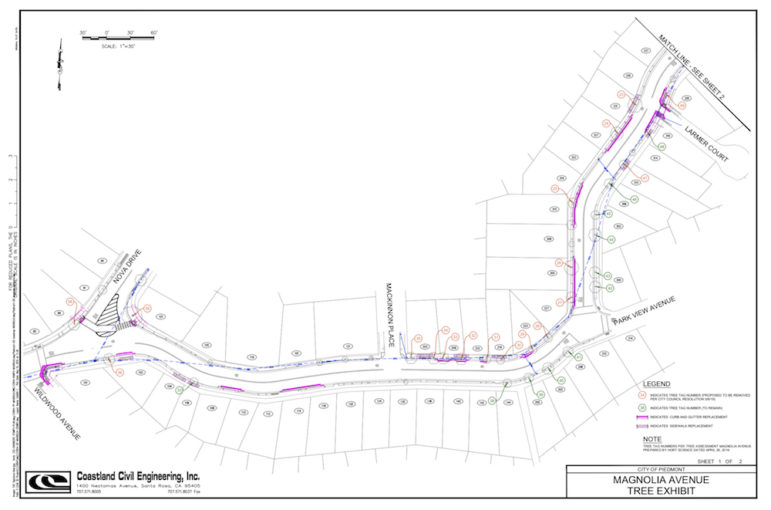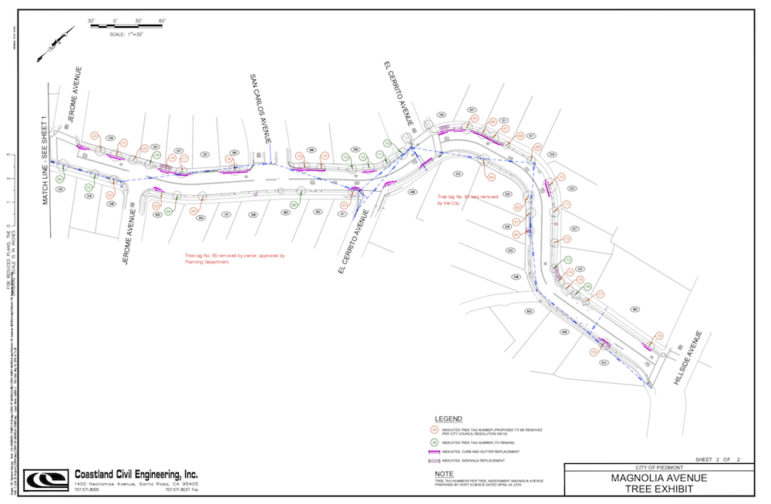OVERVIEW OF THE REVISED GUIDELINES
(Excerpts selected from the Piedmont Planning Consultant and Staff Report)
The draft Piedmont Design Guidelines include seven chapters plus a glossary. The contents are organized as follows:
Chapter 1 (Introduction) – Provides an overview of the document and its objectives, including how to use the Guidelines.
Chapter 2 (Design Review Process) – Describes the different types of Design Review permits required, and the process associated with each permit. The chapter also lists exceptions to 1 An eighth chapter addressing wireless facilities is expected to be added at a future date. Design Review requirements and documents the submittal requirements for applicants seeking Design Review permits. The City’s story pole procedure also is included, as is the protocol for site visits.
Chapter 3 (Site Design) – Includes Guidelines for site design, including the siting and orientation of structures on a parcel, and the design of driveways, parking, landscape features, fences, retaining walls, trash enclosures, and other outdoor site features. The chapter begins with a discussion of neighborhood typologies in Piedmont, which helps provide the foundation for Guidelines and standards that reference “neighborhood context.”
Chapter 4 (Building Design: General) – Provides design principles applicable to all buildings in Piedmont, regardless of occupancy type. The Guidelines apply to single-family homes, multi-family housing, accessory structures, commercial and mixed use buildings, civic buildings, and other structures. Guidelines address exterior building elements, such as facades and architectural details, porches, decks, exterior stairs, roofs, ornamentation, windows, and mechanical equipment. This chapter also identifies green building measures. Chapter 4 begins with a discussion of predominant architectural styles in Piedmont, which provides the context for guidelines and standards that reference design compatibility.
Chapter 5 (Building Design: Single-Family) – Guides the design of single-family homes. It complements Chapter 4, which applies more broadly to all structures, by focusing only on Guidelines unique to single-family homes. The Guidelines cover building scale and massing, the design of garages, accessory dwelling units, and other accessory structures.
Chapter 6 (Building Design: Multi-Family) – Guides the design of multi-family buildings. It complements Chapter 4, which applies more broadly to all structures, by focusing only on Guidelines unique to multi-family housing. The Guidelines cover neighborhood context, building scale and massing, architectural style, and garages and driveways. This is a new section of the Guidelines, applicable only to the 25 or so properties in Piedmont where multi-family housing is a permitted use. Piedmont currently has no Guidelines for multi-family housing, and this section fills that gap.
Chapter 7 (Building Design: Commercial and Mixed-Use) – Guides the design of commercial and mixed-use (commercial and residential) buildings. It complements the Guidelines in Chapter 4, which apply more broadly to all structures. The Guidelines cover neighborhood context, building scale and massing, architectural style, garages and driveways, and signage. This is a new section of the Guidelines, applicable only to the roughly 20 properties in Piedmont where commercial and mixed use development is allowed. Piedmont currently has no guidelines for commercial and mixed use development, and this section fills that gap. A glossary of terms is included at the end of the document. The glossary is not intended as an exhaustive list of architectural terms, but rather as a reference for how commonly used terms are used within Piedmont.
…
The Guidelines rely extensively on graphics to communicate their intent.
In addition to photographs, graphics in the document include:
– A series of “process” flow charts illustrating the Design Review process (sec 2.02-2.04)
– Diagrams illustrating how to display and calculate floor area for zoning calculations (sec 3.03.03
– Diagrams illustrating how to display proposed changes in lot coverage
– Diagrams showing how setback conditions on a street should influence the siting of buildings or additions (sec 3.05.01)
– Diagrams showing siting allowances for accessory and primary structures on single-family lots (sec 3.06.02), multi-family lots (3.06.03), commercial lots (3.06.04), and estate lots (3.06.05)
– Diagrams for driveway and turn-around design (sec 3.07)
– Acceptable locations for trash enclosures (sec 3.10.02)
– Window types (sec 4.03.02)
Window types (sec 4.03.02) While most of these diagrams are new to the Guidelines document, they have long been used separately to communicate existing standards and guidelines, and do not introduce new requirements.
2 One benefit of linking the Guidelines to General Plan and zoning language is the recent SB 35 requirement for “objective” design guidelines for new mixed use and multi-family residential development near transit.
MAJOR CHANGES TO THE EXISTING GUIDELINES
As noted earlier, the draft Design Guidelines under consideration are primarily an update to the 1988 Guidelines, as amended over the last 30 years. Appendix A to this staff report provides a “Crosswalk” between the 1988 Guidelines and the proposed Guidelines. While the new document is longer than the 1988 document, the 1988 document has been augmented over the last 30 years by numerous supplements and memos. Accounting for these supplements, the two documents are similar in size and most of the expanded volume in the proposed Guidelines is attributable to the addition of photos, graphics, and the new commercial/mixed use and multi-family sections.
Substantive changes to the existing Guidelines are highlighted below:
The new Guidelines use a hierarchy that begins with the most general topics, followed by more specific ones. This eliminates a shortcoming of the existing Guidelines, where one needed to hunt for particular guidelines in sections of the document where they did not intuitively appear. For example, many of the “new construction” guidelines in the 1988 Guidelines are regularly applied to remodels and additions, although they do not appear in the “remodels and additions” section of the 1988 document.
Many of the existing guidelines were transferred without modifications. Others were edited to resolve issues that often arise during review of projects by the Planning Commission or Planning staff. For example, Section 3.05 (Compatibility with Street Right-of-Way) now clarifies how existing setback patterns on a block affect where new construction and additions should be sited (relative to the street). Similarly, Section 3.02 has been added to address the factors to be considered when planned improvements are adjacent to public walkways and parks.
Chapters 1 and 2 of the Guidelines are largely new to the document, although the contents of these chapters reflect existing practices and policies. Including a more robust introduction and discussion of Design Review processes and submittal requirements provides the context for the Design Guidelines and facilitates use of the document by applicants.
Section 4.01 on Building Styles has been added to the document, clarifying the determining factors for what constitutes appropriate additions to existing homes.
As noted earlier in this report, Chapters 6 and 7 of the document address construction types that were not addressed in the prior Guidelines. Although the extent of multi-family and commercial/mixed use development in Piedmont is limited, the absence of standards for these uses has created a gap in the past. Recent state housing legislation makes it important Page 6 for the City to close this gap. The new Guidelines also provide more formal design direction on Accessory Dwelling Units (currently only covered through Frequently Asked Questions).
Minor changes to the submittal requirements for Design Review have been proposed (see Section 2.06). Some of these changes reflect requests by staff and/or the Planning Commission Subcommittee. An initial list of proposed changes was presented at the architect stakeholder meeting on September 25, 2018. This list was revised as a result of their input. In addition, a new submittal form has been created to streamline the intake process and assist applicants with their submittal information.




